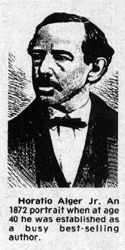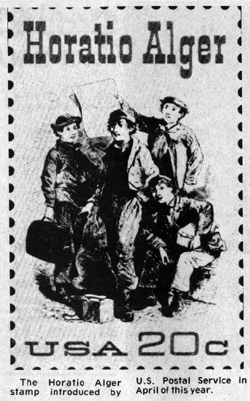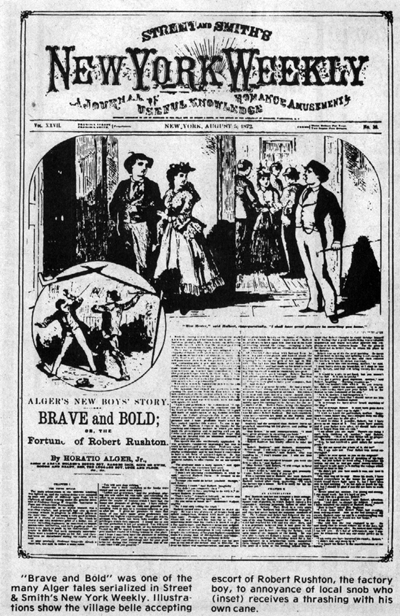November 18, 1982



Picture #1 – Horatio Alger Jr. An 1872 portrait when at age 40 he was established as a busy best-selling author.
Picture #2 – The Horatio Alger stamp introduced by U.S. Postal Service in April of this year.
Picture #3 – “Brave and Bold” was one of the many Alger tales serialized in Street & Smith’s New York Weekly. Illustrations show the village belle accepting escort of Robert Rushton, the factory boy, to annoyance of local snob who (inset) receives a thrashing with his own cane.
Who in my age bracket can forget the Horatio Alger books so popular when he was writing them at the rate of four or five a year, plus many other short stories, poems and magazine serials?
Remember “Do and Date” “The Erie Train Boy” “Fame & Fortune” “Frank and Fearless” “Forging Ahead” “Jed the Poorhouse Boy” “Luck and Pluck” “Live and Learn” “Paul the Peddler” “Ragged Dick” “Risen from the Ranks” “Rough and Ready” “Sink or Swim” “The Telegraph Boy” and many others?
Those are just a few of the books which Horatio Alger wrote during his productive writing career from 1860 until his death in 1899.
The title I selected for today’s Potluck article is the one used by Ralph D. Gardner, a New York advertising man, who like me, became a devotee of Alger many years ago and published his book “Horatio Alger, Or The American Hero Era” in 1964.
It was from his book that I gleaned much data about Alger. It is a book readers of this column can get at Kaubisch Memorial Public Library.
U.S. POSTAL STAMP
How did I come to write today’s article?
Some weeks ago when I purchased stamps at the post office, the clerk handed me some with the title “Horatio Alger” on them, illustrated with familiar faces from some of the Alger books which I read in my boyhood days.
The commemorative stamp was issued April 30 on the 150th anniversary of Alger’s birth in 1832. The ceremony for first-day issue was in Willow Grove, PA, at the George Washington Motor Lodge Convention Center during the annual convention of the Horatio Alger Society.
The stamp was designed by Robert Hallock from the “Ragged Dick” series of six books, which brought Alger national prominence in 1867 and 1868. The designer adapted the stamp illustration from an early Alger edition found in the historical collection at the Pequot Library in Southport, CN.
I must tell you how Ralph D. Gardner fell in love with Alger books, as told in the preface of his book published in 1964.
GARDNER’S DISCOVERY
“I remember as though it were yesterday, the first time I met Horatio Alger. It was near a village in central Maine, late on a mid summer afternoon in 1936. I was 13, and the famed author had been dead exactly 37 years.”
“In the barn up a narrow path behind his house, a Mr. Spaulding stored and traded in such odd-assorted used furnishings as oil lamps, most of them without globes; high-backed rocking chairs, some with a single rocker, some with none; pitchers and washbowls, some cracked, some magnificent; brass bedframes and the usual and unusual accumulations of local attics.”
“In a corner was a mound of books, many mildewed, mouse-nibbled or coverless. The first one to catch my eye was “Frank Fowler”, the Cash Boy, by Horatio Alger Jr.”
“Before scanning to the bottom of the first page, I became an Alger devotee and searched for others, finding a dozen more. It soon was evening and, as shadows spread through the unlighted shed, it became too dark to continue. Respectfully, I knocked on the side door of his cottage, as a sign requested to call Mr. Spaulding and pay for the books.”
“I followed the tall willowy proprietor to the out-building and pointed to my selection.”
“How much do you charge for books, MR. Spaulding? Nickel a piece for the little ones, he answered, a dime for big ones.”
“Algers were “little ones” and having 50 cents, I chose 10 with the most exciting titles or cover illustrations. The rest I replaced in the stack.”
“Mr. Spaulding picked up the three and handed them to me. “Take these along” the kind Yankee said. “They’re too nice to leave.”
“Thanking him, I asked if he found the books in the neighborhood. “Not the Algers, sonny. They’re mine. I read them all when I was younger than you are.”
25 YEARS LATER
“I planned…that summer and many times since..to go back, in hopes of finding other Alger treasures in the dusty pile. But more than a quarter of a century passed before, driving through New England, I made a side trip along that lovely road in Maine”.
“Sentimental journeys often are best left untraveled. There was no trace of the old gentleman. I parked at a general store-post office a mile away, and approached two elderly farmers who sat talking on a bench in front of the railroad station. I told them I was looking for the Mr. Spaulding who sold things in a barn back of his home”.
“Spaulding? the first man repeated the name slowly, digging deep into his memory. ‘Wouldn’t that be Newt Spaulding?’ the second man wondered. No, the first corrected. Twas Chase” Oh Yes, Chase Spaulding’, the second agreed. He’s dead, the first man declared. Many years ago, the second man added.
Perhaps this book should also be dedicated to Mr. Spaulding with whom my adventure began.
ABOUT THE ALGERS
Horatio Alger Jr. was born Jan. 13, 1832 at Chelsea (now Revere) Mass. The first Alger bearing the family name was Thomas, who reached America in the 17th century, coming from England, where the name was pronounced Auger. In accordance with old English grammar, “a” before “i” sounded like “au”. However, records of Raunton, Mass., where Thomas settled, showed that he was registered as “Alger”
In Gardner’s book about the Algers, he says:
Although a majority of the Algers remained at, or returned to their farm after the War for Independence, their numbers eventually thinned. They drifted from the soil to business and professions. Several were practicing law, some already making their names known in politics. A few became physicians. At least a half-dozen preferred the military life, serving with distinction in the War of 1812. There were teachers and writers and ministers who occupied pulpits of the Universalist, Baptist, Congregational, Episcopal and eventually Unitarian denominations.
There were shopkeepers, tradesmen, commission merchants, bankers and industrialists. Algers operated iron foundries, textile mills and shoe factories. Among them were men of triumphant success and others doomed to bankruptcy and heart-breaking failure. There were rich and poor relations, and Algers who toiled throughout the lives to make ends meet, never exactly impoverished. But also never rising above the grayness of unceasing austerity.
WERE HARVARD MEN
Horatio Alger Sr. was a member of the class of 1825 at Harvard and became a preacher. Likewise, his son, the author went to Harvard, graduating in 1852, eighth in a class of 88 and was elected to Phi Beta Kappa. His father had expected him to be a minister too, but even though he did pastor a church for awhile, he finally left it to pursue the work he liked best…writing, for which he seemed best fitted.
Alger’s first book was “Bertha’s Christmas Vision”. The library of Congress still has the proof of the title page of that book, having been deposited Oct. 31, 1855. However, it was not until April 11, 1856, that the book was presented for copyright.
New York in the 1870’s was a busy happy place for Horatio, wrote Gardner in his book. He wrote constantly supply new serialized novels…receiving top prices for his stories, plus royalties rising to 12 1/2 percent.
Alger found the material for his many books and serialized stories on the streets of New York, among the street urchins, newsboys, bootblacks and others who roamed that city. He was active in establishing the Newsboys Lodging House in New York City for those about whom he wrote.
DIED BACK HOME
Alger’s winters were spent in New York during his highly productive years, but he always vacationed in summer at South Natick, Mass., with his family. alger never married, but he always enjoyed being with his parents and other Algers for rest and relaxation.
It was on July 11, 1899, he closed his eyes for a nap and never awakened.
You need never to have read an Alger book to enjoy Gardner’s book, “Horatio Alger, Or the American Hero Era” I highly recommend it.
The book, “Cast Upon the Breakers” was published in serialized form in Argosy Magazine in 1893 under a pseudonym and unnoticed for over 80 years, until 1974, when Doubleday & Co. Inc. published it in book form.